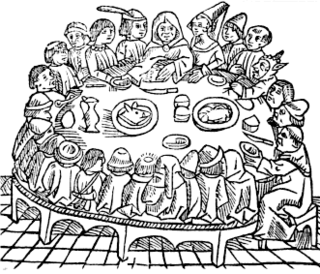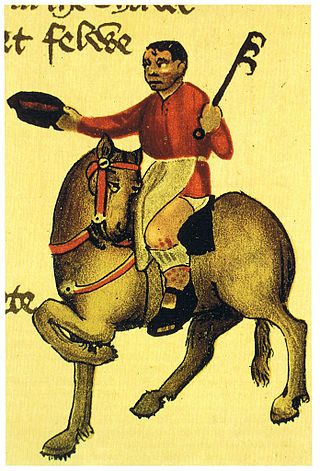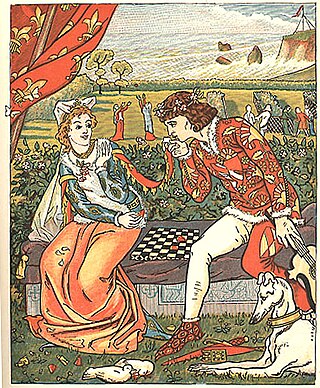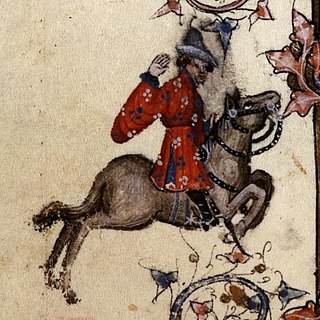
The Canterbury Tales is a collection of twenty-four stories that runs to over 17,000 lines written in Middle English by Geoffrey Chaucer between 1387 and 1400. It is widely regarded as Chaucer's magnum opus. The tales are presented as part of a story-telling contest by a group of pilgrims as they travel together from London to Canterbury to visit the shrine of Saint Thomas Becket at Canterbury Cathedral. The prize for this contest is a free meal at the Tabard Inn at Southwark on their return.

"The Parson's Tale" seems, from the evidence of its prologue, to have been intended as the final tale of Geoffrey Chaucer's poetic cycle The Canterbury Tales. The "tale", which is the longest of all the surviving contributions by Chaucer's pilgrims, is in fact neither a story nor a poem, but a long and unrelieved prose treatise on penance. Critics and readers are generally unclear what rhetorical effect Chaucer may have intended by ending his cycle in this unlikely, extra-generic fashion.

"The Miller's Tale" is the second of Geoffrey Chaucer's Canterbury Tales (1380s–1390s), told by the drunken miller Robin to "quite" "The Knight's Tale". The Miller's Prologue is the first "quite" that occurs in the tales.

"The Wife of Bath's Tale" is among the best-known of Geoffrey Chaucer's Canterbury Tales. It provides insight into the role of women in the Late Middle Ages and was probably of interest to Chaucer himself, for the character is one of his most developed ones, with her Prologue twice as long as her Tale. He also goes so far as to describe two sets of clothing for her in his General Prologue. She holds her own among the bickering pilgrims, and evidence in the manuscripts suggests that although she was first assigned a different, plainer tale—perhaps the one told by the Shipman—she received her present tale as her significance increased. She calls herself both Alyson and Alys in the prologue, but to confuse matters these are also the names of her 'gossib', whom she mentions several times, as well as many female characters throughout The Canterbury Tales.

"The Cook's Tale" is one of the Canterbury Tales by Geoffrey Chaucer. It breaks off after 58 lines and was presumably never finished, although some scholars argue that Chaucer deliberately left the tale unfinished. The story starts telling of an apprentice named Perkyn who is fond of drinking and dancing. Perkyn is released by his master and moves in with a friend who also loves to drink, and whose wife is a shopkeeper whose real occupation is that of a prostitute.

"The Franklin's Tale" is one of The Canterbury Tales by Geoffrey Chaucer. It focuses on issues of providence, truth, generosity and gentillesse in human relationships.

"The Merchant's Tale" is one of Geoffrey Chaucer's Canterbury Tales. In it Chaucer subtly mocks antifeminist literature like that of Theophrastus ("Theofraste"). The tale also shows the influence of Boccaccio, Deschamps' Le Miroir de Mariage, Roman de la Rose by Guillaume de Lorris, Andreas Capellanus, Statius, and Cato. The tale is found in Persia in the Bahar Danush, in which the husband climbs a date tree instead of a pear tree. It could have arrived in Europe through the One Thousand and One Nights, or perhaps the version in book VI of the Masnavi by Rumi. Though several of the tales are sexually explicit by modern standards, this one is especially so. Larry Benson remarks:
The central episode of the Merchant's Tale is like a fabliau, though of a very unusual sort: It is cast in the high style, and some of the scenes are among Chaucer's most elaborate displays of rhetorical art.

"The Reeve's Tale" is the third story told in Geoffrey Chaucer's The Canterbury Tales. The reeve, named Oswald in the text, is the manager of a large estate who reaped incredible profits for his master and himself. He is described in the Tales as skinny and bad-tempered and old; his hair is closely cropped reflecting his social status as a serf. His sword is rusty while he rides a fine gray horse called Scot. The Reeve is a skilled carpenter, a profession mocked in the previous "Miller's Tale". Oswald responds with a tale that mocks the Miller's profession.

"The Pardoner's Tale" is one of The Canterbury Tales by Geoffrey Chaucer. In the order of the Tales, it comes after The Physician's Tale and before The Shipman's Tale; it is prompted by the Host's desire to hear something positive after the physician's depressing tale. The Pardoner initiates his Prologue—briefly accounting his methods of swindling people—and then proceeds to tell a moral tale.

"The Nun's Priest's Tale" is one of The Canterbury Tales by the Middle English poet Geoffrey Chaucer. Composed in the 1390s, it is a beast fable and mock epic based on an incident in the Reynard cycle. The story of Chanticleer and the Fox became further popularised in Britain through this means.
"Sir Thopas" is one of The Canterbury Tales by Geoffrey Chaucer, published in 1387. The tale is one of two—together with The Tale of Melibee—told by the fictive Geoffrey Chaucer as he travels with the pilgrims on the journey to Canterbury Cathedral. The tale concerns the adventures of the knight Sir Thopas and his quest to win the elf-queen.

The General Prologue is the first part of The Canterbury Tales by Geoffrey Chaucer. It introduces the frame story, in which a group of pilgrims travelling to the shrine of Thomas Becket in Canterbury agree to take part in a storytelling competition, and describes the pilgrims themselves. The Prologue is arguably the most familiar section of The Canterbury Tales, depicting traffic between places, languages and cultures as well as introducing and describing the pilgrims who will narrate the tales.

"The Prioress's Tale" is one of The Canterbury Tales by Geoffrey Chaucer.

"The Clerk's Tale" is the first tale of Group E in Geoffrey Chaucer's The Canterbury Tales. It is preceded by The Summoner's Tale and followed by The Merchant's Tale. The Clerk of Oxenford is a student of what would nowadays be considered philosophy or theology. He tells the tale of Griselda, a young woman whose husband tests her loyalty in a series of cruel torments that recall the biblical Book of Job.

"The Shipman's Tale" is one of The Canterbury Tales by Geoffrey Chaucer.
"The Tale of Melibee" is one of The Canterbury Tales by Geoffrey Chaucer.
"The Summoner's Tale" is one of The Canterbury Tales by Geoffrey Chaucer.

"The Canon's Yeoman's Tale" is one of The Canterbury Tales by Geoffrey Chaucer.

The Canterbury Tales is a 1972 Italian film directed by Pier Paolo Pasolini based on the medieval narrative poem by Geoffrey Chaucer. The second film in Pasolini's "Trilogy of Life", preceded by The Decameron and followed by Arabian Nights, it won the Golden Bear at the 22nd Berlin International Film Festival.
The Prologue and Tale of Beryn are spurious fifteenth century additions to Geoffrey Chaucer's Canterbury Tales. They are both written in Middle English.

















